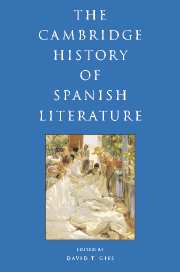Book contents
- Frontmatter
- I INTRODUCTION
- II HISTORY AND CANONICITY
- III THE MEDIEVAL PERIOD
- IV EARLY MODERN SPAIN: RENAISSANCE AND BAROQUE
- V THE ENLIGHTENMENT AND NEOCLASSICISM
- VI THE FORGING OF A NATION: THE NINETEENTH CENTURY
- VII THE MODERN, MODERNISMO, AND THE TURN OF THE CENTURY
- VIII TWENTIETH-CENTURY SPAIN AND THE CIVIL WAR
- IX IN AND OUT OF FRANCO SPAIN
- X POST-FRANCO SPANISH LITERATURE AND FILM
- 52 Spanish literature between the Franco and post-Franco eras
- 53 Post-Franco poetry
- 54 Spanish prose, 1975–2002
- 55 Post-Franco theatre
- 56 Spanish literature and the language of new media
- Bibliography
- Index
- References
54 - Spanish prose, 1975–2002
from X - POST-FRANCO SPANISH LITERATURE AND FILM
Published online by Cambridge University Press: 28 March 2008
- Frontmatter
- I INTRODUCTION
- II HISTORY AND CANONICITY
- III THE MEDIEVAL PERIOD
- IV EARLY MODERN SPAIN: RENAISSANCE AND BAROQUE
- V THE ENLIGHTENMENT AND NEOCLASSICISM
- VI THE FORGING OF A NATION: THE NINETEENTH CENTURY
- VII THE MODERN, MODERNISMO, AND THE TURN OF THE CENTURY
- VIII TWENTIETH-CENTURY SPAIN AND THE CIVIL WAR
- IX IN AND OUT OF FRANCO SPAIN
- X POST-FRANCO SPANISH LITERATURE AND FILM
- 52 Spanish literature between the Franco and post-Franco eras
- 53 Post-Franco poetry
- 54 Spanish prose, 1975–2002
- 55 Post-Franco theatre
- 56 Spanish literature and the language of new media
- Bibliography
- Index
- References
Summary
The death, after a protracted agony, of Francisco Franco on 20 November 1975 has left its mark on Spanish historiography. The mark may be indelible, but it remains contentious. Many have attempted to ignore or eschew the death, the dictator, and the date as so many attributes of a conception of history still in thrall to powerful people, famous proper names, and neat chronologies. Many others preserve and even promote Franco’s passing as a watershed event, indispensable to any serious reflection on modern Spain. Still others point to the assassination by ETA of Franco’s likely successor, Admiral Luis Carrero Blanco, in late 1973 as the event to remember. Regardless, the terms “post-Franco” and “post-Francoist” hold for literary historians and critics in ways that do not obtain for the writers themselves. Nor are the problems of such classificatory moves resolved by invoking Post-modernism, which, despite some critics’ claims to the contrary, constitutes yet another classification. As Manuel Vázquez Montalbán notes, post-Francoism and Post-modernism alike are indicative of a “voluntad de sóntesis” (“will to synthesis”) that is necessarily reductive. That Post-modernism should signify synthesis and reduction is ironic, and partly accounts for its increasingly nugatory status as an epistemic and heuristic category. The decline of Post-modernism does not, however, invalidate its “successes, ” significantly among them, as Gonzalo Navajas observes, “la legitimaci ón definitiva de discursos prohibidos y minoritarios” (“the definitive legitimization of prohibited and minoritized discourses”). Spain in the wake of Franco did indeed seem to refashion itself into Post-modern playground of raucous desires.
- Type
- Chapter
- Information
- The Cambridge History of Spanish Literature , pp. 705 - 723Publisher: Cambridge University PressPrint publication year: 2005



